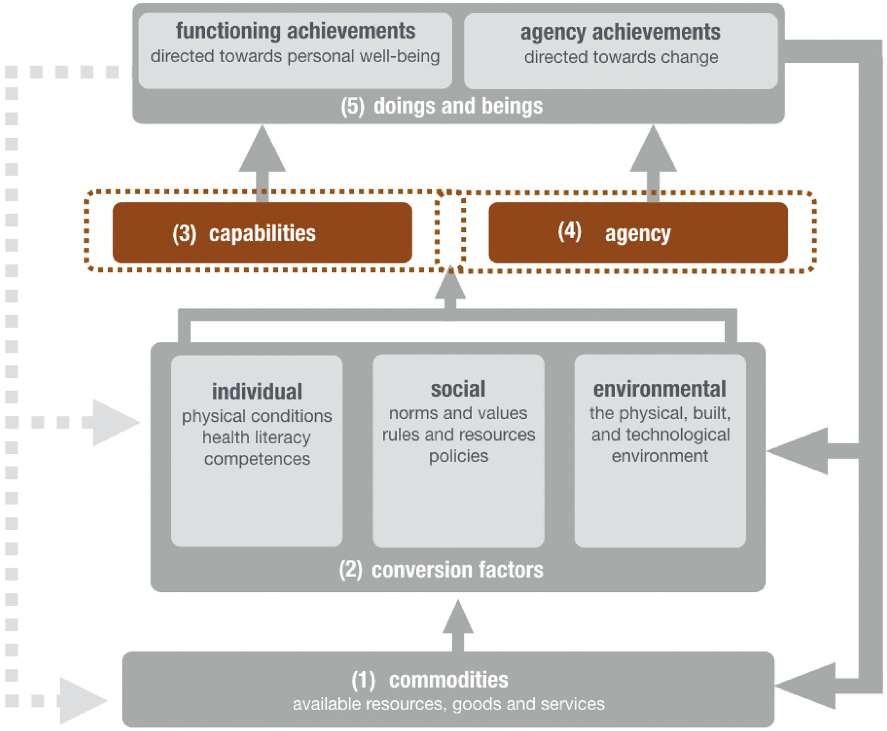Capability-Ansatz Literaturempfehlungen
Durch den Verbund Capital4Health konnte der Capability Ansatz für die Gesundheits- und Bewegungsförderung weiterentwickelt und ein Rahmenkonzept für Interventionsforschung auf Basis des Ansatzes entwickelt werden. Ebenfalls konnte ein Konzept zur Messung von bewegungsbezogenen Handlungsmöglichkeiten entwickelt und wissenschaftlich validiert werden.

- Till, M., Abu-Omar, K., Ferschl, S., Abel, T., Pfeifer, K. & Gelius, P. (under review). Using the capability approach in health promotion projects: A framework for implementation.
- Till, M., Abu-Omar, K., Ferschl, S, Reimers, A.K. & Gelius, P. (2021). Measuring capabilities in health and physical activity promotion: a systematic review. BMC Public Health21, 353. https://doi.org/10.1186/s12889-020-10151-3
- Frahsa A., Abel T., Gelius P., Rütten A., on behalf of the Capital4Health Research Consortium (2020). The capability approach as a bridging framework across health promotion settings: theoretical and empirical considerations, Health Promotion International, https://doi.org/10.1093/heapro/daaa076
- Sauter, A., Curbach, J., Rueter, J., Lindacher, V. & Loss, J. (2019). German senior citizens’ capabilities for physical activity: a qualitative study, Health Promotion International, 34(6), 1117–1129, https://doi.org/10.1093/heapro/day077
Wie empfehlen nachfolgende Texte zum besseren Verständnis des Ansatzes
Capability Grundlagen
- Robeyns, I. (2005). The Capability Approach: a theoretical survey. Journal of Human Development, 6(1), 93-117. https://doi.org/10.1080/146498805200034266
- Nussbaum, M. (1999) Women and equalitiy: The capabilities approach. International Labour Review, 138, 227-245.
- Sen, A. (1980). Equality of what? The Tanner lecture on human values, 1, 197-220.
Capability und Gesundheit
- Altgeld, T. & Bittlingmayer, U. (2017) Verwirklichungschancen/Capabilities. In: Leitbegriffe der Gesundheitsförderung und Prävention, Bundeszentrale für gesundheitliche Aufklärung. https://doi.org/10.17623/BZGA:224-i126-1.0
- Gutwald, R. (2016) Der Capability-Ansatz als Grundlage für die Beurteilung von Lebensqualität in der Medizin. In Kovacs, L., Kipke, R. and Lutz, R. (eds), Lebensqualität in der Medizin, Springer VS, Wiesbaden. pp. 157-174.
- Kinghorn, P. (2015) Exploring different interpretations of the Capability Approach in a health care context: Where next? Journal of Human Development and Capabilities, 16(4), 600–616, http://doi.org/10.1080/19452829.2015.1110567
- Stephens, C., Breheny, M. and Mansvelt, J. (2015) Healthy ageing from the perspective of older people: a capability approach to resilience. Psychology & Health, 30, 715-731. https://doi.org/10.1080/08870446.2014.904862
- Abel, T., & Frohlich, K. L. (2012). Capitals and capabilities: linking structure and agency to reduce health inequalities. Soc Sci Med, 74(2), 236-244. https://doi.org/10.1016/j.socscimed.2011.10.028
- Bittlingmayer, Uwe H.; Ziegler, Holger (2012) : Public Health und das gute Leben: Der Capability-Approach als normatives Fundament interventionsbezogener Gesundheitswissenschaften?, WZB Discussion Paper, No. SP I 2012-301, Wissenschaftszentrum Berlin für Sozialforschung (WZB), Berlin
- Ruger, J. P. (2010). Health capability: conceptualization and operationalization. Am J Public Health, 100(1), 41-49. https://doi.org/10.2105/AJPH.2008.143651
- Abel, T., & Schori, D. (2009). Der Capability-Ansatz in der Gesundheitsförderung: Ansatzpunkte für eine Neuausrichtung der Ungleichheitsforschung. Österreichische Zeitschrift für Soziologie, 34(2), 48-64. https://doi.org/10.1007/s11614-009-0012-9
Capability Messinstrumente
- Helter, T. M., Coast, J., Laszewska, A., Stamm, T., & Simon, J. (2020). Capability instruments in economic evaluations of health-related interventions: a comparative review of the literature. Qual Life Res, 29(6), 1433-1464. https://doi.org/10.1007/s11136-019-02393-5
- Ferrer, R. L., Cruz, I., Burge, S., Bayles, B. and Castilla, M. I. (2014) Measuring capability for healthy diet and physical activity. Annals of Family Medicine 12, 46-56. https://doi.org/10.1370/afm.1580
- Leßman, O. (2013) Empirische Studien zum Capability-Ansatz auf der Grundlage von Befragungen – ein Überblick. In Graf, G., Kapferer, E. and Sedmak, C. (eds), Der Capability-Approach und seine Anwendung. Fähigkeiten von Kindern und Jugendlichen erkennen und fördern, Springer VS, Wiesbaden. pp. 25-62.
- Hofmann, K., Schori, D. and Abel, T. (2012) Self-Reported Capabilities Among Young Male Adults in Switzerland: Translation and Psychometric Evaluation of a German, French and Italian Version of a Closed Survey Instrument. Social Indicators Research, 114, 723-738. https://doi.org/10.1007/s11205-012-0170-1
- Anand, P., Hunter, G. and Smith, R. (2005) Capabilities and Well-Being: Evidence Based on the Sen–Nussbaum Approach to Welfare. Social Indicators Research, 74, 9-55. https://doi.org/10.1007/s11205-005-6518-z

